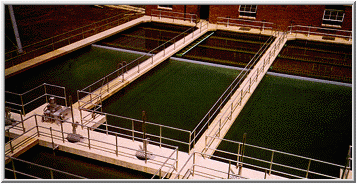
The inlet should have bottom-near feed openings to have an as small intermixing zone as possible between the activated sludge/water mix and the tank content. Inlet dimensions are important sizes The density flow can be substantially influenced by the inlet structure by minimizing the potential and kinetic energy of the wastewater stream with a suitable feed design. To increase the separation efficiency of tanks, the density flow should be minimized or the engineering process modified in a way that the density flow will be integrated with the sedimentation process.

The rising density flow initiates back flow of the clarified water on the surface. The density flow sinks to the tank bottom during inflow and passes to the tank end. The density of flows has a strong influence on the separation efficiency. Of particular importance is the design of the inlet section as turbulences are generated there by mixing with the wastewater inflow which may have an intense influence on the sedimentation process. It is important to recognize that the process-engineering installations in rectangular sedimentation tanks have a great influence on the performance of this final treatment stage. However, changed process concepts with a bottom-near inlet and concurrent skimming are able to minimize such turbulences to such an extent that the sludge load and thus the separation efficiency can be increased. This concept is based on the empirical knowledge of normally minor turbulence in the tank.


2/3 to 1/3 of the tank depth and the skimming direction in the counter flow. Beside the clarified water discharge, the feeding method for the sludge/water mix and the skimmer system have an essential influence on the separation efficiency in tanks. An essential prerequisite for upgrading plants is the question whether the settling volume for activated sludge is sufficient. The basis of upgrading consists in changed process concepts which are able to exploit the unused potential of existing tanks.

Expansion is an expensive solution and impossible if the available space is scarce so that a new construction has to be built. With ever tightening legislation, however, the question of expansion or upgrading of existing sewage treatment plants arises. Dimensioning these vessels according to existing guidelines guarantees safe operation. The process concept for sedimentation tanks has hardly changed over the past 80 years.


 0 kommentar(er)
0 kommentar(er)
